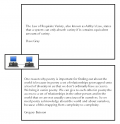Two Great Early Cyberneticists
[ by Charles Cameron — Ashby, the Law of Requisite Variety, Bateson, the arts and sciences ]
Mapping from complexity to complexity. Access to a set of relationships … that we are not usually conscious of in ourselves. The depth and riches of imagination, of the arts and sciences, of the listening heart / mind, of the world around us, of the models we need to make to navigate that world successfully… of the wisdom our steersmen need, and all too often lack.
Zen‘s post Ruminating on Strategic thinking had me thinking a bit, and I guess I felt some of his bullet points,
- Assessment of the relationships among the variables
- Assessment of the relationship between the variables and their strategic environment
- Assessment of current “trajectory” or trend lines of variables
- Assessment of costs to effect a change in the position or nature of each variable
- Assessment of the strengths and weaknesses of the variables as a functioning system
and particularly
- Recognition of systemic “choke points”, “tipping points” and feedback loops.
are separable as components one might learn, but need to fuse into a single intuition if the result is to be fully system-responsive.
And I think the two comments above by Ashby and Bateson are in their own ways both “about” that — about the need for a gestalt understanding rather than a list of separate and disparate parts…
*
And of course, those two quotes can also be used to pitch for cybernetics, or for poetry, or both… much to my delight!

zen:
December 22nd, 2011 at 6:02 am
Hi Charles,
.
“are separable as components one might learn, but need to fuse into a single intuition if the result is to be fully system-responsive.”
.
Coup d’œil is close if you take a broader meaning than even Clausewitz used. Gestalt understanding as you noted fits what you are trying to express and Zen has concepts like Joriki that has some utility in the sense of understanding seamlessly merged with execution. No one word though quite catches the gestalt of strategy.
Charles Cameron:
December 22nd, 2011 at 8:07 am
Well, Zen, your reference to Clausewitz‘s coup d’oeil got me thinking. You’ve mentioned it before, as I now recall, so I can’t claim to be completely unaware of the usage, but it had certainly slipped my mind, and I am not well enough read in the Old Master himself or in strategic studies to have it spring easily into awareness. So my response to your list was a spontaneous expression of how it seems to me such things must work, and I’m delighted to find that other minds than mine were here before me, and to find them specifically within the field of strategic thinking, and in Clausewitz himself no less.
.
All of which adds up to me feeling the urge to google, and to learn a bit — so I wound up reading [dipping into, really] William Duggan’s Coup d’oeil: Strategic Intuition in Army Planning — with which most of your readers may well already be familiar, but which was new ground for me. Ah, the realizations of the extent of my own ignorance that I get from reading and posting on this site!
.
And here’s the part that amazes me: in Duggan’s piece, there’s a quote from “Gordon and Berger, Intelligent Memory“:
That’s astounding: “The dots are pieces or ideas, the lines between them are your connections or associations.” Voila — the basic format of a HipBone move. “The lines can coalesce into larger fragments, and these fragments can merge to form a whole thought.” Voila — a HipBone Game! —
.
— the main difference, as I see it, being that the process Gordon and Berger describe takes place within the subliminal workings of a single brain, whereas in my games a single person or group of people in collaboration works to achieve precisely this effect, consciously and deliberately — calling on the exact same unconscious process for the choices of individual “thoughts” (moves, in game terms) and “connections or associations” (links claimed).
.
So the games are in effect a fractal continuation of a pattern already implicit [subliminally present] in all creativity.
.
Permit me to crow a little, having earlier in this comment done penance for my ignorance.
.
I hadn’t quite seen it that way before, although of course I knew the games were marvelous devices for eliciting creative leaps and linkages. But for sure, that paragraph will be of great help in explaining just what I’ve been up to these last fifteen or twenty years, and why I think it’s important…